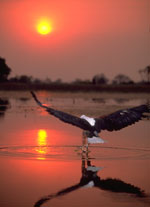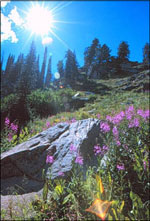The energy of the sun, captured by plants and passed on to animals, powers everything in our world — dolphins leaping out of the ocean, geese moving across the sky, people stirring their morning oatmeal.

Set in our ways.
Photo: Art Wolfe, Inc.
This truth contains beautiful poetry: It teaches us that in our children’s laughter, we can hear sunlight laugh with joy. There are days when that simple thought can make the whole world feel like a cathedral to me.
But this truth also contains an unalterable rule: There is only so much energy on Earth, and all the interconnected, complicated, essential parts of the living system cannot survive without a share of it. A healthy culture would recognize that fact, and structure itself accordingly.
A culture like that would be stunned by our own society, in which humans co-opt 32 percent of the total solar energy captured by land plants, according to a study in the Dec. 21 issue of Science. Ecologists know this because they can measure the plant biomass created each year, something called the Net Primary Production, or the NPP, and estimate how much of it is diverted away from the rest of life by human activities.
We use some of the NPP directly. We eat it, we wear it, we use it to build our homes. But this accounts for only a small fraction of our total share. We also influence the productivity of land. Land that has been paved over can’t contribute to the NPP. Plantation forests and monoculture crops are much less efficient at funneling solar energy into the biosphere than the forests and prairies they replace.
Human control of NPP influences the composition of ecosystems in ways that aren’t always controllable or predictable. The solar energy flowing through a cornfield won’t find its way to some of the specialized birds and insects that populate a prairie, because those prairie creatures don’t have the faintest idea what to do with corn stalks or corn earworms. Our control of the NPP creates ripples — extinctions, the arrival of pests, shifts in the make-up of ecosystems. If these ripples grow large enough, they have the potential to harm essential parts of our life-support system. The bigger the rock you throw in a pond, the bigger the ripples. That’s why the NPP is a number worth tracking. It gives a sense of the size of the rock we are throwing in the biosphere.
Not that the number is easy to track, let alone easy to interpret. The human share of the NPP could be as low as 10 percent or as high as 55 percent. No one knows how small a share the rest of nature can get by on. Are we taking so much of the Earth’s productivity that we risk damaging something we depend upon for survival? We cannot know that answer. No animal species in the history of life has taken such a large share of the photosynthetic pie, so there is no past record to help judge how far we are from crisis.
The most sophisticated global ecologist cannot define the dangers inherent in appropriating so much of the NPP, but you don’t have to be able to write a treatise on satellite imaging or statistical analysis to understand the prudence of sharing whatever we can with the life-forms that keep the world in working order.

Sunny, happy landscape.
Photo: ArtToday.
Only a species with incredible creativity and drive could have claimed so much of life’s energy stream for its own. The challenge now is to redirect our talents to the work of learning to live on a smaller fraction of the Earth’s productivity. Here and there, people are beginning to do just that, living out their conviction that humans can live in harmony with natural processes. People like Wes Jackson and his colleagues at the Land Institute are learning how to partner with a prairie ecosystem to grow grain and also improve the soil. Others, like John Todd, assemble “Living Machines,” mini-ecosystems that purify water and recycle nutrients.
These people and their projects fascinate us and give us hope. But what they offer most of all is a question. What would happen if the best minds of a generation adopted this approach and began searching for ways to form partnerships with nature? What might we discover if even a fraction of the time and energy invested in developing technology for extracting from nature were instead invested in understanding how to work in concert with natural systems?
On the hill above my house a tree sapling grows on practically bare rock. It came to grow there, I think, because for years moss and lichens grew in that spot, meeting their own needs while creating out of rock, rain, and sunlight enough soil for a tree to sprout. There’s some more poetry for you — a life lived in a way that makes soil from rock. This is a kind of magic we cannot accomplish on our own. But by learning from and partnering with natural systems, we could begin to share in that magic; we could learn how to meet our needs without degrading the natural riches all around us.
We are accustomed to the idea that livers and gallbladders and alfalfa and oaks function in ways that contribute to larger living systems. But most of us who have grown up in industrial cultures don’t consider it our purpose to serve the life of the planet in a similar way. It is hard to find parts of the biosphere made richer by human activities.
Jackson’s prairie agriculture and Todd’s living machines prove that we could, at the very least, do less harm. Their work hints that we might even find a role for ourselves in restoring land and water and building up natural capital.
The report in Science on the NPP makes a strong scientific case for this new approach, but in the end, I think it will be the poetry of it that brings us around.

